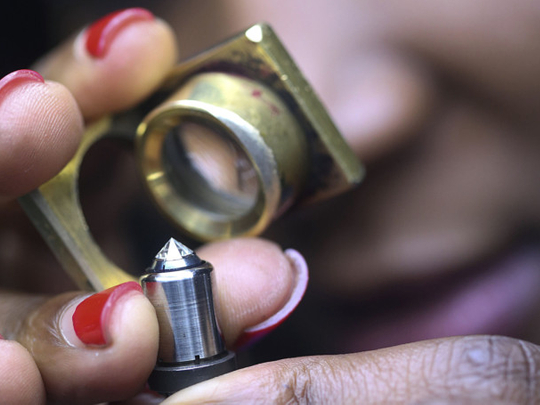
LONDON: In a tiny nondescript room, up a musty and yellowing staircase behind a Mexican restaurant in London’s Mayfair, a group of master craftsmen are painstakingly working on diamonds worth millions of pounds. The 77 Diamonds’ workshop — one of only a handful left in Britain, as 90 per cent of jewellery purchases here are made abroad — is alive with activity.
Stones of every size, colour and clarity are being set, mounted, buffed and shaped; the air tastes thick with gold filings and buzzes to the tune of myriad miniature drill bits. However, rather than ending up in a strobe-lit showroom, these diamonds will be couriered into the hands of an online shopper who may never have seen it in — or on — the flesh before purchase.
Welcome to the brave new world of diamond buying; and a growing breed of consumer who thinks nothing of spending six figures on the jewel to seal the deal, at the click of a mouse.
Largest online business
According to 77 Diamonds, Europe’s largest online diamond jeweller, business has never been brisker.
“This January was off the charts,” enthuses co-founder Tobias Kormind, a former investment banker at Morgan Stanley, who remortgaged his flat to launch the business in 2006 alongside Vadim Weinig, a former diamond polisher and risk manager. “We are ridiculously over target.”
The company boasts the biggest selection of diamonds of any website worldwide, and was last year reported to be on course to turn over £25 million (Dh128 million).
As well as off-the-peg rings, necklaces, earrings, cufflinks and bracelets, they offer a bespoke service where clients can click to design engagement and wedding rings or pendants, tweaking the stone’s shape, cut, colour and clarity, while windows pop up to ask whether you need help with the design, before a 360-degree video displays your final choice.
The aim was to compete with the world’s finest jewellery companies at a price that would blow them out of the water by cutting out the middleman wholesale market; buying direct from manufacturers; and cutters from all over the world and passing the savings on to consumers.
The result has been a business model that touts up to 76 per cent cheaper deals than high street stores such as Tiffany or Graff, and is part of a sea change in consumer spending habits on high-ticket jewellery. It is Kormind’s belief that consumers have never been savvier and old models of in-store consultations and hidden price hiking are outdated.
“We are trying to get ahead of the curve. It has happened in every other space: look at Amazon. Price transparency brings consumers who are empowered and have never been more demanding.”
But what of millennials?
Already they’ve been deluged with inquiries for look-a-like Meghan Markle engagement rings based on her three-stone design with a cushion-shaped centre diamond. Cushions are, apparently, very in.
“Millennials still consider diamond jewellery as one of the main aspirational gifts you can give,” says Kormind. “The attitude of different generations hasn’t changed. If anything, social media and Hollywood’s influence through these platforms has put more pressure on them.”
Of course, not everyone buys diamonds for someone else or waits for someone to give them to them. “We’re finding people, women especially, are more empowered to purchase them for themselves,” says Kormind.
“Classic diamond jewellery — studs and the eternity ring — are also rewards when you’ve had a good year or a good bonus for yourself.”
Back in the workshop, I meet master craftsman Stephen Barnard, an enchanting man with 50 years’ experience in the jewellery business, who has worked on creations for Victoria Beckham and Princess Diana as well as the Burton-Taylor pear-shaped gem that was valued at a cool £14.4 million.
After passing through Boodles and Garrard, he settled here five years ago, for a future cutting internet-bought gems.
“This is the way trade is going,” he insists. “People want simplicity. Tastes have changed. In the old days, I’d spend days making an elaborate ring, but now they want something simple and to invest in the stone.”
New ways to pick gems
Man-made diamonds In the past decade, the science of creating gem-quality diamonds in a modern-day lab has been perfected - offering peace of mind that they’ll be conflict-free, with flawless clarity and the same chemical composition of their geologically created counterparts.
Recycle heirlooms
Transforming grandma’s centrepiece sapphire from a broken necklace into a bespoke piece of jewellery cuts the cost and ups the sentiment.
Compare the market Plug in your preference for cut, price, carat, shape and colour and let rarecarat.com - described as “Kayak for diamonds” - aggregate the results. There’s an artificial intelligence chatbot called Rocky on hand if you get stuck. Go vintage
Vintage designs increase in value over time whereas recreations do not. Ensure you go to a reputable dealer and ask if it has been restored in any way, which can affect price.
The Daily Telegraph












